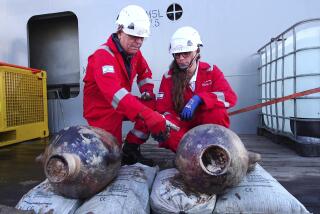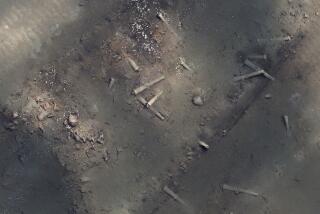Amphora Tied to Trade Route
An amphora taken from a shipwreck on the floor of the Black Sea last summer has provided the first direct evidence of an ancient trade route in the region, U.S. researchers are expected to announce today.
The clay vessel, about the size of a modern 55-gallon drum, was made near Sinop, Turkey, on the southern coast of the Black Sea and was packed with salted fish from the northern coast. Its destination was Greece, where the amphora would be refilled with olive oil or wine for shipment back to the Black Sea, said oceanographer Robert Ballard of the Institute for Exploration at the Mystic Aquarium in Connecticut.
For the record:
12:00 a.m. March 15, 2003 For The Record
Los Angeles Times Saturday March 15, 2003 Home Edition Main News Part A Page 2 National Desk 1 inches; 45 words Type of Material: Correction
Amphora -- A Jan. 16 article in Section A incorrectly stated that an amphora, a clay vessel, recovered from the floor of the Black Sea had a 55-gallon capacity. Amphorae come in many sizes, but the most common have a capacity of about eight gallons.
Radiocarbon dating of the contents shows that the ship carrying the amphora sank between the 5th and 3rd centuries BC, making it the oldest shipwreck found in the Black Sea, although Ballard has found an older wreck -- dating from 750 BC -- in the Mediterranean.
“This discovery provides historians with the first look at an actual wreck from a key era of trade in the Black Sea known previously only through written records,” Ballard said at a news conference organized by the National Geographic Society, which sponsored the expedition.
The team has so far recovered only the one amphora from the wreck. It will return this summer to explore the crew quarters of the ship and determine who sailed it.
Researchers are excited by the findings because the Black Sea, which played a key role in the development of Western culture, was off limits to explorers for decades during the Cold War. Access to much of it was not regained until after the breakup of the Soviet Union in 1991.
“We’re finally getting a chance to piece together what happened there over many centuries,” said archeologist Fredrik Hiebert of the University of Pennsylvania.
The Black Sea is expected to be a fertile hunting ground for marine archeologists because, unlike other large bodies of water, it contains no oxygen at depths greater than about 600 feet. All the oxygen once there was consumed by the disintegration of organic matter, and there is no water circulation to restore it.
“That means there is no marine life, particularly nothing that can eat wooden ships,” Ballard said.
His team has already discovered several wooden ships in the Black Sea that appear to be well preserved. The amphora, however, came from a wreck in much shallower waters off the Bulgarian coast, about 275 feet below the surface.
Photos of the site show only the ship’s cargo, a layer of 20 to 30 amphorae sitting atop what appears to be a second layer.
Ballard speculates that some of the ship’s structure may have been preserved in the mud, which contains little oxygen.
When researchers opened the amphora, they found that it contained fish bones atop a layer of resin that either had been used as a sealant or was left in the jar by a previous cargo of wine.
Ichthyologists determined that the fish were large freshwater catfish that most likely were harvested on the northern shore’s Crimean peninsula.
Marks on the bones indicate that the fish had been cut up into dried steaks, called tarichos in ancient Greek.
The dating showed that the bones were between 2,490 and 2,280 years old.
The ancient Greek geographer Strabo wrote that some of Greece’s supply of tarichos was imported from the Black Sea region near the Crimea.
More to Read
Sign up for Essential California
The most important California stories and recommendations in your inbox every morning.
You may occasionally receive promotional content from the Los Angeles Times.










